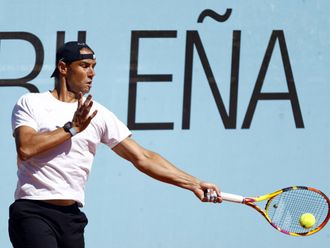
Melbourne: Five-time Australian Open champion Serena Williams blasted the fastest serve of her career against Japan’s Ayumi Morita Saturday as she gained valuable court time in her bid for a sixth title.
The American third seed had raced through her opening two matches at Melbourne Park for the loss of just two games but was made to work harder by Morita — and she said the longer rallies were just what she needed.
“I feel today was actually a really good match for me,” said Williams, after beating the Japanese number one 6-1, 6-3.
“I was involved in a lot of longer points, something I definitely wanted. I feel good. I hope I can keep this level up and go higher.”
Williams followed defending champion Victoria Azarenka onto Rod Laver Arena and could meet her in the semi-finals if the draw pans out as scheduled, with a potential final against Maria Sharapova.
“She’s playing great. I think she’s doing everything well,” she said of Sharapova, who thumped Serena’s sister Venus in the third round on Friday.
“I have to get there. I have three more matches to win. I can’t worry about that right now. I just have to take everything a step at a time.”
Of more immediate concern to Williams is her fourth round opponent on Monday, 14th-seeded Russian Maria Kirilenko, a player she has beaten five time out of five.
“Maria (Kirilenko) is playing consistent tennis, especially the past 16, 18 months, she’s been so consistent,” said Williams.
“So my goal is just to be really focused against such a player that’s doing so well.”
Against Morita, Williams easily won the first game but was then pushed on her serve, before stepping it up with a blistering backhand down the line, giving her a break for 3-1.
There was no stopping the American, with Williams firing down her equal fastest serve of 207 kilometres per hour — also clocked in round two against Garbine Muguruza — on her way to taking the set in 31 minutes.
But the 15-time major-winner, who has an eye on the first calendar-year Grand Slam since 1988, wavered in the second set and Morita raced to a 3-0 lead.
It was a short-lived advantage with Morita imploding and Williams reeling off six games in a row to easily clinch the match.
“I went for it, but I wasn’t going for it that hard,” she said of her super-quick serve, which achieved a speed rarely seen in the women’s game.
“Every time I go for it, to hit it really hard, it goes in the 190s. When I hit the 207, I was like, “OK, the first one wasn’t luck, maybe I can hit a 207”. So it was pretty cool.
“I’ve never gone 207, so I’ve never gone faster than that.”
Legendary American tennis coach Nick Bollettieri was watching the game and was impressed by Williams.
“Serena serve motion smooth as silk,” he tweeted. “Motion is perfect, full extension of arm and racket, lift and power from legs.”
Meanwhile, Victoria Azarenka admitted on Saturday she needs to improve “everything” to successfully defend her Australian Open title after surviving a scare against injured American Jamie Hampton.
The top-seeded Belarusian came through the match on Rod Laver Arena 6-4, 4-6, 6-2 but it was much tougher than the scoreline suggested against a player who was wincing in pain from a back problem.
The world number one knows she was lucky to get through, and asked what parts of her game she needs to improve, she replied: “Simple: everything.
“It was definitely tough,” she added. “It’s always good to know you can battle through not playing well, not feeling great.
“It’s important to be alive in the tournament. Towards the end things were going better for me. I’m glad about that, but definitely she played an outstanding match.”
The plucky Hampton had never contested a Grand Slam third round before, and gave it her all in a match packed with quality rallies and tight games.
She later revealed she had two herniated disks in her lower back.
“I had back problems. Hurt my back last year at the French Open pretty badly,” she said.
“It’s something I deal with day-to-day, and, yeah, it was hurting. Normally when my back starts hurting I start cramping.”












